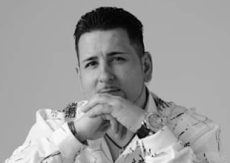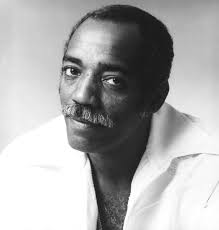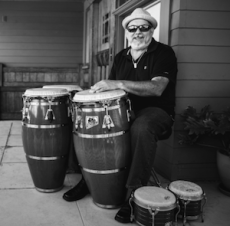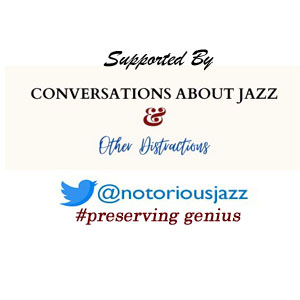
ARMANDO VEGA & 313 ORCHESTRA
Sonero y Conguero Armando Vega grew up immersed in Latin music and culture in Detroit, Michigan. Beginning to sing Salsa at seventeen, he received early mentoring from Herman Olivera, famed Grammy nominated singer with Eddie Palmieri, The Spanish Harlem Orchestra, and many others. Years later Armando performed with Olivera before a crowd of 30,000 at the Cleveland Puerto Rican Festival. He has promoted his own CD touring Puerto Rico, opening for Latin greats El Gran Combo de Puerto Rico, and many other prominent PR artists. He has also performed with Elias Lopes, one of Puerto Rico’s most influential Latin Jazz trumpeters. He has toured and headlined with Tito Puente, Jr., and recorded his own CD produced by Latin jazz saxophonist Luis Disla. Armando has established an enthusiastic following in and beyond Detroit.
More Posts: adventure,album,club,conga,festival,genius,jazz,museum,music,preserving,restaurant,travel

Three Wishes
While hanging out with Nica having conversation one evening, she inquired of Willie Bobo that if given three wishes that would be granted what would he wish for and he replied:
- “Health.”
- “Wealth.”
- “Time to enjoy it!”
More Posts: baroness,conga,history,instrumental,jazz,music,pannonica,percussion,three,timbales,wishes

PONCHO SANCHEZ COMES HOME
A Thanksgiving Celebration
Poncho Sánchez is an American conguero, Latin jazz band leader, and salsa singer. In 2000, he and his ensemble won the Grammy Award for Best Latin Jazz Album for their work on the Concord Picante album Latin Soul.
More Posts: adventure,album,club,conga,festival,genius,jazz,museum,music,preserving,restaurant,travel

Daily Dose Of Jazz…
Armando Peraza was born May 30, 1924 in Lawton Batista, Havana, Cuba and was orphaned by age 7 and lived on the streets. By twelve he was supporting himself by selling vegetables, coaching boxing, playing semi-pro baseball, and becoming a loan shark. His music career began at seventeen when he heard at a baseball game that bandleader Alberto Ruiz was looking for a conga player and Ruiz’s brother was on the same baseball team as him. Despite the absence of experience in music, he practiced and won the audition.
He left Cuba for Mexico in 1948 to tend to his sick friend, conga drummer Mongo Santamaría. They arrived in New York City in 1949 and after playing in Machito’s big band, Peraza was invited by Charlie Parker to participate in a recording session that included Buddy Rich. He recorded with Slim Gaillard in New York Cuty in 1949 in a session that produced Bongo City and toured the U.S. with him band until they reached San Francisco, California. He spent time in Mexico recording with Perez Prado and did some soundtracks for the Mexican movie industry.
Returning to the U.S. he settled in San Francisco, worked with Dizzy Gillespie, toured extensively with Charles Mingus and Dexter Gordon, and played with Puerto Rican actor and musician Tony Martinez. Armando led an Afro-Cuban dance review at the Cable Car Village Club in San Francisco, attracting a clientele from Hollywood that included Errol Flynn, Marlon Brando, and Rita Hayworth.
By 1954, he was working with pianist Dave Brubeck, Peraza met Cal Tjader, and jazz critic Leonard Feather recommended Peraza to Fantasy Records to record an Afro-Cuban album with Tjader. The result was Ritmo Caliente, which combined Afro-Cuban rhythms with a jazz sensibility. Following this he met George Shearing through bassist Al McKibbon and he spent the next twelve years with the pianist, a collaboration that put Peraza at the forefront of Afro-Cuban music.
Armando emerged as a composer, writing and recording twenty-one songs for Shearing, such as Mambo in Chimes, Mambo in Miami, Ritmo Africano, Armando’s Hideaway, This is Africa, and Estampa Cubana. These recordings were during the mambo craze in the U.S. and the world. In 1959, he joined Mongo Santamaría for the Mongo album, then became a member of Cal Tjader’s band for six years, followed by a stint with drummer Shelly Manne.
He recorded one solo album, Wild Thing, was the first Afro-Cuban percussionist to add conga drums to a rock track, an in 1972, at the age of 47, Peraza joined the rock band Santana, influencing andtrmining for nearly twenty years and played to millions of people around the world, partnering with percussionists José Areas, Mingo Lewis, Raul Rekow, and Orestes Vilató. He wrote or co-wrote sixteen songs recorded by Santana.
Peraza retired from Santana in 1990 at the age of 66, played a Santiago de Chile concert with Santana in 1992, returned to Cuba after fifty year absence in 202, and recorded on the John Santos, 20th Anniversary in 2005, At 82 years of age, in 2006 he made a rare appearance with Santana for a three show performance at the Montreux Jazz Festival in Switzerland. In 2007, he received a Lifetime Achievement Award from the Voices of Latin Rock, who present the Armando Peraza Award for achievement in the San Francisco Bay Area every year.
On April 14, 2014 Latin jazz percussionist Armando Peraza who played congas, bongos, and timbales transitioned from complications of pneumonia. He was 89.
More Posts: bongo,conga,history,instrumental,jazz,music,timbales

Daily Dose Of Jazz…
Rafael Antonio Cortijo was born on December 11, 1928 in Santurce, Puerto Rico and as a child became interested in Caribbean music and enjoyed the works of some of the era’s most successful Bomba y Plena music musicians. Throughout his life, he had a chance to meet and work with some of them and learned how to make his own congas and pleneras, the handheld drums used in bomba y plena music.
He met salsa composer and singer Ismael Rivera when both were youngsters growing up in the Villa Palmeras neighborhood. They became lifelong friends and Rivera impressed with his friend’s conga-playing skills, asked him to join his orchestra, which played at Fiestas patronales all over Puerto Rico.
Becoming well known across Latin America, Rafael attributed his success to the sound of his percussion, as Afro-Caribbean music was known worldwide. As a member of the Conjunto Monterrey, based in Monterrey, Mexico, he later toured with Daniel Santos’ orchestra and worked on radio.
By 1954, as a member of El Combo, Cortijo’s big break came when El Combo’s leader and pianist Mario Román left the band to him. Ismael Rivera, then the lead singer of Lito Peña’s Orquesta Panamericana, joined Cortijo’s orchestra known as Cortijo y su Combo in 1955. From then until 1960, his orchestra played live on Puerto Rican television shows, and sometime during the 60s, they became the house band at La Taberna India.
The orchestra virtually disbanded in 1962 when Ismael Rivera was arrested for drug possession in Panama. Rafael and the other bandmates went on to found Puerto Rico’s salsa group, El Gran Combo. He went on to create another orchestra, El Bonche, where he was joined by his adopted niece, Fe Cortijo, who would become a well-known singer on her own. He and Rivera went on to live in New York City but he soon returned impoverished to Puerto Rico, where he forged a friendship with composer Tite Curet Alonsothe who helped produce a comeback album. In 1974, Coco Records reunited all the former members of “Cortijo y su Combo” orchestra for a one-time-only concert and a subsequent studio recording issued a few months afterward.
Their friendship was so important to Rivera, that when orchestra leader, musician, and composer Rafael Cortijo passed away of pancreatic cancer on October 3, 1982 at his sister Rosa Cortijo’s apartment in the Luis Llorens Torres public housing project in Santurce, Rivera said he would no longer sing.

More Posts: bandleader,conga,history,instrumental,jazz,music



